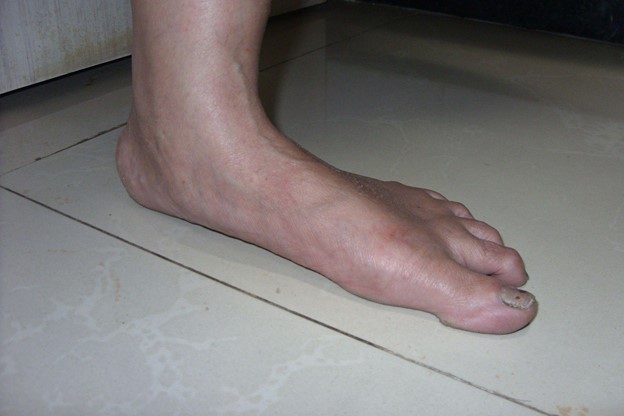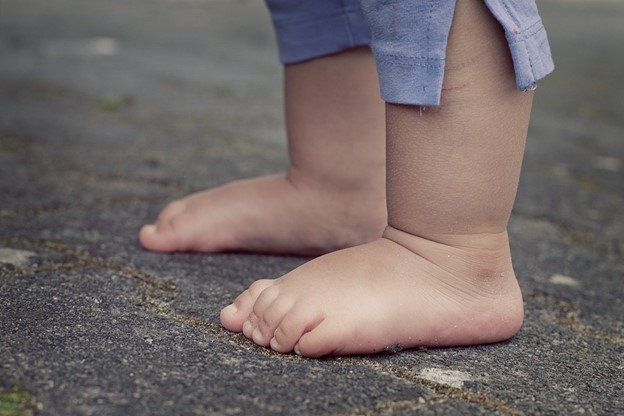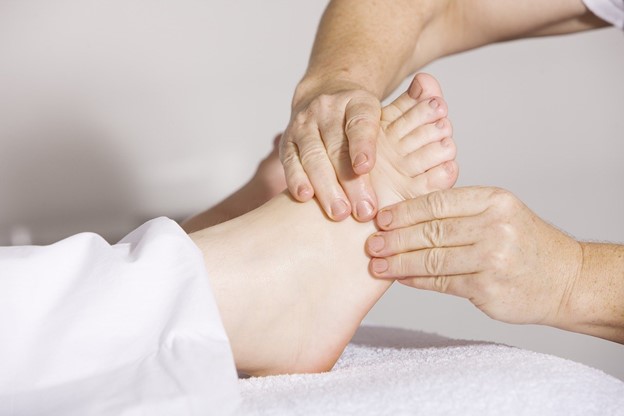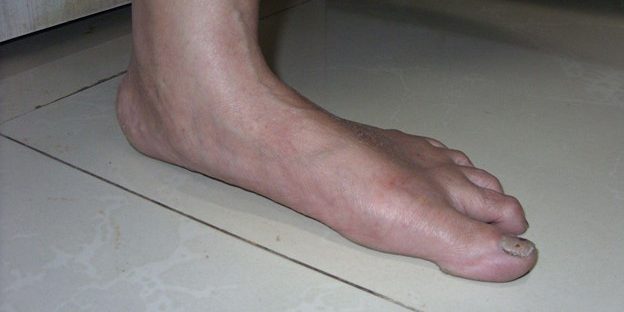Flat feet, also known as fallen arches or pes planus, is a deformity where one or both feet show little to no arch. This can be observed when the entire soles or pads of the feet touch the ground when standing up. Know flat feet causes, symptoms and treatment in this post.
 This condition is common to children as they’re still developing their muscles but can be brought into adulthood. Other times, flat feet are acquired from injuries or other underlying illnesses.
This condition is common to children as they’re still developing their muscles but can be brought into adulthood. Other times, flat feet are acquired from injuries or other underlying illnesses.
Although usually painless, a person with flat feet should seek treatment if it causes them to experience foot pain or discomfort in other parts of the body. Since flat feet cause poor alignment, this can lead to pain or swelling in the feet, ankles, legs, knees, hips or lower back.
What are the different types of flat feet?
Flat feet can vary depending on how the condition presents itself or how it is developed. Here are the general types of flat feet.
Flexible Flat Foot
A foot is considered to have a normal arch if there is an upward curve in the middle. However, if your arch disappears when standing, then this means that you have flexible flat feet. This is the most common type for children or toddlers and is usually painless.
Rigid Flat Foot
If there is no visible arch regardless of whether you are sitting or standing, then you have rigid flat feet. This type typically develops in the teen years and unlike flexible flat feet, may cause foot pain and discomfort.
Adult-Acquired Flat Foot
An adult-acquired flat foot or fallen arch happens when the arch of an adult unexpectedly collapses, commonly due to injuries. The loss of arch is caused mainly by posterior tibial tendon dysfunction where the tendon in the ankle that supports the arch is injured or torn.
This condition can cause your affected foot and the inner side of the ankle to feel pain as long as the arch isn’t fully supported.
Vertical Talus
Another type of flat feet is a birth defect or congenital disability called vertical talus. This happens when the talus bone is in the wrong position causing other bones to misalign as well. In effect, the bottom of the foot has no arch and may curve out, resembling the bottom of a rocking chair.
Although this is initially painless in early childhood, leaving it untreated can lead to adverse effects later on.
How to test yourself for flat feet?
If you’re unsure if you have flat feet or fallen arches, there is an easy test you can do to check.
Simply wet your feet and step on a surface. This can be on a concrete sidewalk, bathroom tile, or any flat ground that will show your footprint.
Step away and observe your footprints. If you can see the complete shape or the whole imprint of your feet in the footprints, then you are likely to have flat feet. It is also possible to have this condition for only one foot or both.
What are the symptoms of flat feet?
The most obvious symptom or characteristic of flat feet is the lack of arch when putting weight on the foot. For most people, flat feet don’t cause severe pain and show other symptoms.
However, some experience pain in the arches, ankle, heel, and sides of the foot.
Muscle pain or cramps in the foot or lower legs are also common due to the lack of support given by the feet.
Aside from that, fallen arches or flat feet can have the following symptoms:
- Plantar fasciitis, which happens when the tendons in the foot are inflamed
- Overpronation or rolled-in ankles
- Bunions or the dislocation of big toe joints
- Hammertoes or contracted toes
- Swelling or stiffness in the hip, knee, or lower back
- Abnormal patterns or difficulty in running and walking evenly
- Shoes wearing down quickly because of the uneven distribution of body weight
What causes flat feet?
 Typically, a human foot is composed of 33 joints, 26 bones, and hundreds of muscles, tendons and ligaments. These parts all work together to allow movement and carry our weight.
Typically, a human foot is composed of 33 joints, 26 bones, and hundreds of muscles, tendons and ligaments. These parts all work together to allow movement and carry our weight.
The arches on our feet develop when tendons tighten as we grow. These serve as added support in distributing our weight across our feet and legs.
Aside from maintaining balance, arches also provide spring to our steps. It is also important that arches are strong to adapt to a variety of surfaces.
Flat feet in children
All babies have flat feet once they are born since the tendons still need time to tighten and form the arch. As their bodies start to develop properly, their feet also start to form normal arches without any problems.
However, some people don’t outgrow their flat feet and don’t develop any arch. In some rare cases, this can be caused by congenital conditions like vertical talus and tarsal coalition, which is the abnormal positioning and connection of the bones in the foot, causing pain later on.
Genetics also plays a factor as to why other people don’t develop arches.
Flat feet in adults
Other people develop flat feet over time. Some factors or underlying conditions that cause flat feet include the following.
Physical injuries
One of the most common causes of flat feet in adults is physical injuries to the heel, ankle or feet. This includes damage or rupture of the posterior tibial tendon, broken or dislocated bones, tight Achilles tendon or tendonitis and other injuries to the Achilles tendon.
Illnesses
Flat feet can also arise in adults as a result of health conditions or diseases. An example of a health condition that causes fallen arches is arthritis or rheumatoid arthritis, which usually starts in middle age.
Diseases that affect the nervous system or muscles can also cause flat feet including spina bifida, cerebral palsy, Down syndrome and muscular dystrophy.
Aging
Other times, arches fall simply due to age or years of wear and tear which weakens the posterior tibial tendon. This usually happens after continuous application of stress or weight and long-term use of the feet.
Who is at risk?
 Depending on the conditions, some people are more at risk to develop flat feet. Highly athletic people are prone to foot and ankle injuries which makes them more likely to develop fallen arches.
Depending on the conditions, some people are more at risk to develop flat feet. Highly athletic people are prone to foot and ankle injuries which makes them more likely to develop fallen arches.
Obesity and pregnancy are also risk factors due to the excess weight that the feet have to carry. Pregnant women are also likely to have loose joints or increased laxity which can lead to flat feet.
Other health conditions that are considered as risk factors are diabetes, and hypertension.
How do you fix flat feet?
Since flat feet or fallen arches are typically painless, consulting a doctor is not always necessary. However, if there is any significant pain, there are always treatments available to manage it.
Diagnosis
If you’re concerned, you may ask help from your healthcare provider to get your flat feet diagnosed. Diagnosing flat feet also includes identifying the possible causes of your condition.
Flat feet can be diagnosed by observing or examining your feet when you sit, stand, or walk. The strength of your muscles and tendons may also be tested to see if there are injuries to your Achilles tendon or posterior tibial tendon.
Doctors may also order a series of tests such as X-ray, CT scan and MRI scan to thoroughly check your bone structure.
They may also examine your medical history to see if some past injuries or illnesses may be related to the condition.
Treatment of flat feet
 In treating flat feet, the main goal is to provide additional support to the feet and to strengthen the feet, legs and ankles. This can be achieved through different treatments that are listed below.
In treating flat feet, the main goal is to provide additional support to the feet and to strengthen the feet, legs and ankles. This can be achieved through different treatments that are listed below.
Supportive devices
The first treatment option for flat feet is using appropriate supportive devices like orthotics. Children may also be prescribed to use custom-made shoes until their arches fully develop.
These shoes and foot orthotics aim to reduce pressure and pain on the foot and help distribute body weight.
Physical therapy
Physical therapy is another treatment available for flat feet. This aims to strengthen and tighten the tendons on your feet and ankles.
Your healthcare provider or physical therapist may also teach you diet and exercises you can do by yourself to relieve pressure on your feet and reduce weight, if necessary.
Medication
In cases of sustained inflammation and swelling, your healthcare provider may recommend non-steroidal anti-inflammatory drugs (NSAIDs) as a treatment. These medications, along with rest and ice, can help reduce pain.
Surgery
Depending on the severity of the case, the doctor may recommend surgery as a treatment. This is usually the last resort when non-surgical treatments aren’t enough to relieve pain.
Common surgical procedures for this condition include repairing tendons, fusing bones or joints, changing the shape of the bone or lengthening the Achilles tendon.
How to prevent flat feet?
Oftentimes, flat feet in children are hereditary or caused by genetics which means they can’t be prevented. For adults without flat feet, however, staying at a healthy weight and avoiding foot or ankle injuries are some ways of preventing flat feet.
Measures can also be taken to prevent your condition from worsening such as wearing the appropriate footwear or foot support.
Flat feet concerns? Contact Adelaide Foot and Ankle
If you are experiencing discomfort due to flat feet, it’s important to consult a doctor to ease the pain and possible inflammation. Contact us today to get the proper care you need. We’ll provide you with comprehensive care so you can get back on your feet in no time!





